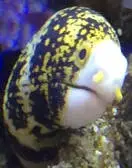
Echidna nebulosa
| Difficulty | Low |
| Minimum Tank Size | 50 Gallons |
| Diet | Carnivore |
| Water Parameters | 72-78 F, pH 8-8.4, Salinity 1.020-1.025 |
| Aggression | Semi-Agressive |
| Size | 2' |
The Snowflake Eel has earned a special place in my heart and is the first eel I’ve ever owned. Their constant smile and fun feeding habits make them a great addition to any tank with semi-aggressive, larger fish that it cannot attack.
Their bodies are mostly white with black and yellow splotches across their body. These form rings, giving this eel a yellow zebra like appearance. Their nose has two tubes that help them smell and find food.
Growth Rate
Because eels can vary so much in length this deserves its own section. Snowflake Eels will grow from a short 8″ eel into a foot and a half in only 6 months. This is both good and bad news.
The good side of this is that new owners may purchase a Snowflake Eel in a much smaller tank than they need. A young Snowflake Eel will be fine in a 20 gallon tank.
Once the eel ages a few months you will need to upgrade the tanks size. The Snowflake Eel is extremely hardy, and moving tanks will not cause them too much stress. This means you may transfer the Eel between multiple tanks. With mine I went straight from the 20 breeder(short/longer tank) into the final home of a custom built 65 gal.
Diet & Feeding
First and foremost, do not feed these guys by hand. I have seen so many people do this, I’ve even done it myself. However if the eel choose your hand, or misses his strike, you will get quite a painful bite. Use tongs or a skewer to feed them a varied diet. Do not use something sharp enough to harm the eel, as they can strike their prey with significant force.
Calamari, shrimp, mussels, silversides, crab and fish are all part of the snowflakes diet.
Keep in mind that Snowflake Eels have horrible eyesight. They will frequently miss their food, even letting it pass right by them. For this reason I always use larger pieces of food with less frequent feedings.
Once they are more comfortable in the tank feeding them is really fun. Just be sure they stay in the tank and can’t be hurt by whatever it is you are using to feed them.
Aggression
While these eels may look silly, they are still predators and will eat just about anything that can fit into their mouth. This will include crabs and shrimp, more commonly so for these pebble teeth eel, but varies from eel to eel. Be sure your clean up crew consist of shelled snails and larger fish only. Otherwise you may find your tank in the midst of an algae bloom.
The Snowflake Eel is a nocturnal predator, but will still hunt occasionally during the day. These are the best times to feed the eel, as he will accept almost any type of food while hunting.
Remember: Snowflake Eels grow to be two feet long and can easily eat many popular fish. Even when well fed there is always a small chance they will strike at your fish. Stick to large fish or fast fish which the eel will not be able to catch. My eel never once bothered any of my blennies, as they can go from a stand still to a puff of dust in the blink of an eye.
A final note is that Snowflake Eels are generally not aggressive towards other eels. The issue here is that two eels require a much larger tank. Only consider a second if you have something bigger than a 50 gallon.
Breeding & Sexing
I’ll be blunt here. Breeding the Snowflake Eel is next to impossible. There is no noticeable difference between genders and keeping multiple eels is typically more of a challenge than a breeder will want to deal with. You would have to sit and pray that your eels do pair before any sort of breeding can begin.
Snowflake Eels are protogynous, meaning the more dominant eel will change from female to male. Again this brings more issues, as eels are generally peaceful towards one another. Gender changing can take several months to a year, which is far longer than most breeders are willing to wait. For this reason you are best off adding two eels and forgetting about the matter entirely for now.
Once the two have paired you will need to ensure they have plenty of room and are well fed.
From here on out it is simply wait and see, as Snowflake Eels will almost never reproduce in captivity and no known methods have proven to encourage breeding.
Extra Notes
- Keep a tight, closed lid at all times. Eels are known escape artists/carpet surfers. They will frequently escape the tank, leading to either their death or a panicked aquarist returning them to the tank.
- These Eels can survive for 12 hours out of water. Never give up on the eels until they have died. Chances are they will bounce back.
- These Eels are reef safe.
- If they become sick try soaking their food in garlic extract. This will help boost their immune system, typically bringing them back into good health.
For more information about feeding check my new page on what eels eat.